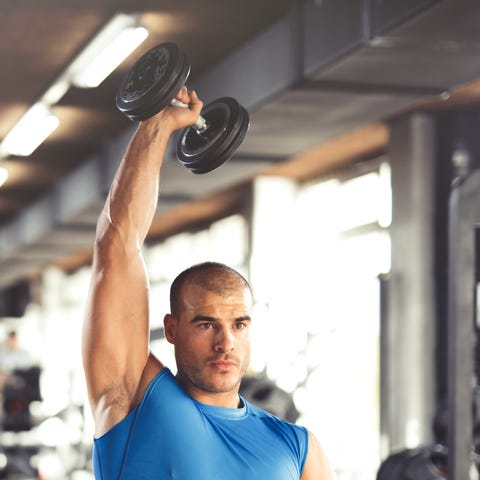
CrossFit 19.3 is the latest workout in the illustriously murderous CrossFit Open, a brief but ultra-badass challenge designed to help you prove your fitness mettle. It’s an unexpected workout that’ll leave your entire body in shock, with a move you may never have practiced at your local CrossFit box as its centerpiece.
It’s also not worth your time and energy, because it’s a shoulder injury waiting to happen. And if you’re smart, you’re going to walk away from this one, instead of tearing a delicate shoulder tendon while undertaking this 10-minute bout with stupidity.
Here’s the thing with CrossFit: Not every workout is bad. After nine years of the CrossFit Open, you’ve very likely heard both sides of the CrossFit narrative. Its proponents will tell you that it’s the ultimate fitness competition, that it creates a unique sense of fitness community, and that it’s the one workout that can get an average Joe to push his heart rate through the roof. Its critics, meanwhile, will tell you that its workouts are injuries waiting to happen, and that every new box that opens is worth a new Lamborghini to your local chiropractor.
The truth about CrossFit, in my opinion, lies somewhere in between. But 19.3 manages to be the worst of CrossFit.
All About The Shoulders
Here’s Training 101: You progress to everything. You work towards a 225-pound bench press by gradually increasing your bench press, work toward a complicated gymnastics move by breaking it into smaller parts, mastering each part, then performing the whole. And once you’ve gained some mastery over the move, you can test yourself in that move.
Here’s what 19.3 does: It attempts to fatigue the most delicate joint in your body, then it tests that joint in a brand new position that’s nobody could prepare for, that some CrossFit boxes don’t even train, and that half the population isn’t ready for: The strict handstand pushup.
You’re in a dangerous position to start 19.3. Well before reaching the handstand pushups, guys hoist a single 50-pound dumbbell overhead, hold it there, and lunge 200 meters. You can switch the weight between hands at any time, but regardless of that, you have a hefty amount of weight above your shoulders for a sustained period of time.
Why is that bad? Because most humans, courtesy of desk jobs and a variety of other issues, can’t even find the overhead position correctly.
An Anatomy Lesson

Science Photo LibraryGetty Images
Getting a straight arm directly overhead in truly balanced, controlled, and safe fashion requires you to do more than you think. First, your deltoid, your meatiest shoulder muscle, raises your arm so its nearly perpendicular to the floor — but it’s not the only muscle doing the work. To finish things up and get your arm fully perpendicular with the floor, a handful of smaller back muscles must also contract.
Most people don’t execute this as cleanly as you think. Stand in front of your mirror, so you can see the side of your torso, and try lifting your shoulder overhead. Before you reach that fully-perpendicular position, did your ribcage start to open up? Did you start to arch your back?
These are all compensations for a lack of pure shoulder mobility, and they’re more common than you think. They’re also present in even the best athletes, top NFL and NBA players and MLB stars.
To small degrees, they’re not helpful, but to larger degrees, they can be cause for concern. If you can’t get your shoulder overhead with clean (or close-to-clean) mechanics, there’s a chance that the humerus (the long bone of your upper arm) can get very close to your clavicle (your collarbone) as you approach that overhead shoulder position.
When the space between those two bones get close, in that overhead position, your rotator cuff tendons can get squeezed by bone, and get an opportunity to fray. That’s how shoulder tendon issues very often start. And shoulder tendon issues don’t go away easily, like muscle pulls and some other injuries.
Back to 19.3
What does this have to do with 19.3? How’s your overhead position? Do you actually know beyond the kip that’s saved your pullups and saved your handstand pushups since the beginning of your CrossFit education?

Emir MemedovskiGetty Images
Do you know how to safely hoist and hold a 50-pound dumbbell overhead while controlling that ribcage flair? Do you pull your shoulder blade and shoulder complex down to do that? Or do you keep pushing up? And does it matter, since you’re going to work to a nasty fatigue point? Because here’s what people do when they get fatigued: They revert to their most natural mechanics. Oh, and those mechanics break down and get sloppy, too.
Shoulder can’t take it? Well, if you’re keeping that dumbbell up high, something else will take the brunt of the work. So you’ll arch through your mid-back (your thoracic spine) or, worse, you may arch your lower back. CrossFit 19.3 offers to zones for this nightmarish positioning: The overhead lunges at the beginning and the handstand pushups later on.
The Shoulder Dangers of CrossFit 19.3
So here’s what happens in 19.3: You start out with 200 feets of hell that are designed to put you in bad shoulder and back positions. You’re doing these lunges with that single dumbbell overhead, shouldering a heavy load.
You should be pushing your shoulder high as you do this, trying to create as much joint space as possible through the entire motion. But by the end of 200 feet, you can expect to have a good layer of fatigue from all that overhead work. Your shoulder might even be a little bit sore.
Your reward for that overhead work: A quick breather for your shoulders in the form of some box step-up work (thanks CrossFit!). And then, after a few scant minutes, it’s onto more shoulder-isolating work in the form of handstand pushups.
And these handstand pushups are special for several reasons. Among them: CrossFit wants you loading your shoulders more than you ever have before on a handstand pushup. If you’ve ever been to a CrossFit class with handstand pushups, you’ve seen a handstand turn into a headstand, then turn into a barely-there handstand, with every CrossFitter in the gym dipping their legs low, then missiling those legs back upwards to create momentum and help drive their shoulders upward.That’s how CrossFitters are most familiar with the handstand pushup, how they’ve been trained to do it, and how they’ve learned to judge and push past their shoulder fatigue.
That’s not how you’ll do them in 19.3. In 19.3, you’re doing 50 “strict” handstand pushups (or as strict as CrossFit likes to make its arbitrary, self-serving movement standards in that you’re still using a wall). By removing the kip, from the equation, you’re now loading your shoulders that much more aggressively, in something closer to a standard military press.
Military presses are great and all, except this press occurs with your torso upside down, with plenty of bodyweight load, and with your feet against the wall. That creates a ton of opportunity for back arching as you look for ways to alleviate some of the new strain on your shoulders. And that’s a ton of opportunity for injury.
Your CrossFit 19.3 Plan
Walk. Away. Unless you’re trying to win the Games, you don’t need this challenge, because it’s not a smart one. One of the strengths of CrossFit is the creativity of its programming; it’s because of CrossFit that EMOMs and AMRAPs are well-known.
The weakness of CrossFit has long been an inability to marry that creativity to smarts and safety. Single workouts rarely consider anterior/posterior balance, fail to consider the risks of overhead pressing (hey, look at 19.3!), and don’t understand the sheer stupidity of the American kettlebell swing (but that one’s another column). And 19.3 is a programmed shoulder nightmare waiting to happen.
So why even bother doing it? No, it’s not easy to walk away from a fitness challenge, especially one in a “competition” that’s designed around the idea that you, too, dear Average Joe, are an “athlete.” And that’s partly why CrossFit bills its competition around the idea that its competitors are “the fittest athletes on Earth”: It’s designed to make you feel like an athlete when you run yourself through a brick wall of pain and shoulder soreness.
Newsflash: The true fittest guys on earth, the true “athletes,” the NFL players and NBA stars and world-class sprinters? Those athletes only run themselves through brick walls of pain and soreness and Toradol because they get paid. Pro athletes know when not to do a competition, because it’s not worth it.
Be a pro on this one, and pass on it. Don’t get lured in by the mystique of CrossFit, especially when doing the RXed weights on this one. There are safer ways to build your shoulders.
In a decade, when you’re not earning any money for your CrossFit exploits, but you’re still trying to stay in shape, your body will thank you.
Source: Read Full Article